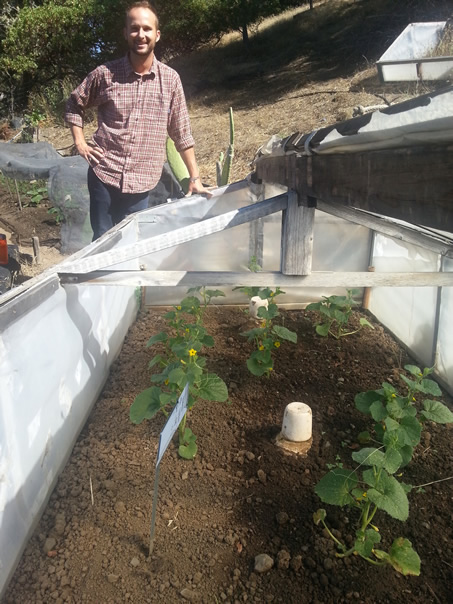Hunter Flynn joined the EA Headquarters Mini-Farm team in May 2013 in the role of a staff Farmer. He will be assisting Eric Buteyn, Mini-Farm Manager. His special focus at the site will be on arid farming. He describes below his arrival and new role.

Hunter surveys the bed where buried ollas are irrigating young melon plants.
As I left the San Francisco Bay Area and headed into the wooded mountains of Mendocino County, I was filled with mixed emotions and expectations. I was leaving my family, friends, business and urban lifestyle to move into a rustic cabin at Ecology Action's Headquarters. I would be living and working with seven other individuals on a mini-farm perched high above a town of 4,900. Would I grow tired of these people quickly and feel stuck on this mountain without outlet?
I arrived at the Headquarters site with its beautiful view of Little Lake Valley and was soon greeted by staff and interns. We are eight people total, from five different countries, speaking ten different languages, representing five different religions, each of us with unique stories and backgrounds. As the first week progressed, we worked in the garden, participated in class and workshops and shared our meals together. This is a special group, with each person dedicated to doing something "big" in his or her home country, once equipped with the knowledge learned at Ecology Action. Loneliness is not an emotion I have experienced since arriving here, and we are anything but bored with our days filled in the garden and nights consumed by endless homework assignments related to sustainable agriculture.
Early in my employment with Ecology Action I was asked to place a special focus on arid farming practices and techniques. Arid farming, as defined by the Rural Science Series, is "the profitable production of useful crops, without irrigation, on lands that receive an annual rainfall of 20 inches or less." This subject is so important to our research because nearly one half of the whole area of the United States receives 20 inches or less of rainfall annually. If you add to this the area receiving between 20 and 30 inches, then 63% of the United States falls into the category that would benefit from the practice of arid farming. Also, according to available data, 36% of the Earth's land surface is in desert, and this amount is increasing at an accelerated pace.
This summer, in the arid section, we are testing sunken beds (against our traditional raised beds), which are said to protect plants against evaporation from overexposure to wind and sun. In addition, we are using two designs of olla jars to irrigate our crops. Ollas are unglazed ceramic jars fired at a low temperature so as to be more permeable. The large ollas or jars, which hold approximately 5 gallons, are buried in the soil with just the neck of the olla above ground. We transplant seedlings around the neck of the olla at a range from 3 to 15 inches, and water slowly seeps from the jar to the surrounding soil, thus irrigating the plants. The neck of the olla is covered with a cap to minimize evaporation, and the cap contains a small hole that collects any potential rainfall. Here we are placing 5 ollas per 100-sq-ft bed, and refilling them about every four days with 1.25 gallons of water per olla. This system of ollas is said to use much less water than traditional forms of irrigation, something we will be measuring carefully as the summer progresses. Already, after only 17 days, we have used only 10 gallons of water to irrigate a 50-sq-ft bed of melon!